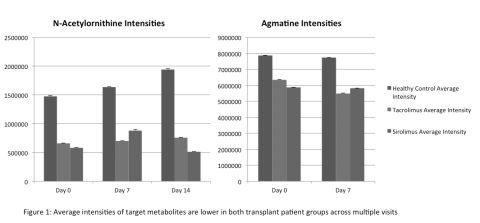Metabolomic Distinctions between Renal Allograft Recipients on Monotherapy Sirolimus or Tacrolimus Maintenance Therapy
Emory Transplant Center, Emory University, Atlanta, GA
Clinical Biomarkers Laboratory, Emory University, Atlanta, GA
Meeting: 2013 American Transplant Congress
Abstract number: B1094
Background. Sirolimus and Tacrolimus have distinct mechanisms of action with distinct side effect profiles. In order to gain mechanistic insights into the differing effects of these two immunomodulatory drugs, we utilized metabolomics to investigate a unique population of renal transplant patients maintained on a steroid-free monotherapy regimen of either sirolimus or tacrolimus. Untargeted analysis was followed by targeted pathway mapping to explore metabolic differences between these patients and healthy controls.
Methods. Plasma was collected at multiple time points from three groups on stable drug regimens: transplant patients on monotherapy tacrolimus (TAC; n=8), monotherapy sirolimus (SIR; n=3), and healthy controls (HC; n=9). Samples were run on an LTQ-Velos Orbitrap mass spectrometer and extracted using apLCMS. False discovery rate (FDR) analysis was performed using a q=0.01. Kyoto Encyclopedia of Genes and Genomes (KEGG) was used for pathway mapping.
Results. FDR analyses between HC, TAC, and SIR subjects revealed that N-acetylornithine and agmatine were, on average, lower in transplant patients relative to HC. KEGG pathway mapping based on these metabolites showed that arginine and proline metabolism was significantly affected between the patient groups.
Discussion. The lower average levels of N-acetylornithine and agmatine in transplant patients suggest that, relative to healthy controls, there is a suppressed utilization of arginine in the immunosuppressed population. This relative deficit of arginine has been shown to exert an inhibitory effect on mTOR-mediated cell survival, T cell proliferation, and protein synthesis. Furthermore, downstream products of N-acetylornithine are involved in cellular regeneration, wound healing, and repair. These data provide a mechanistic explanation for wound healing impairment in transplant patients, and serve as a basis for additional exploration into the fundamental differences between these drugs. We are currently assessing the intracellular metabolomic signature for these patients.

To cite this abstract in AMA style:
Kim S, Park Y, Cheeseman J, Mehta A, Jones D, Kirk A. Metabolomic Distinctions between Renal Allograft Recipients on Monotherapy Sirolimus or Tacrolimus Maintenance Therapy [abstract]. Am J Transplant. 2013; 13 (suppl 5). https://atcmeetingabstracts.com/abstract/metabolomic-distinctions-between-renal-allograft-recipients-on-monotherapy-sirolimus-or-tacrolimus-maintenance-therapy/. Accessed December 26, 2025.« Back to 2013 American Transplant Congress
